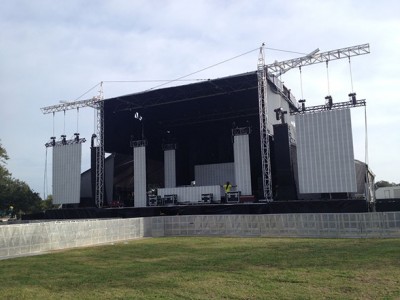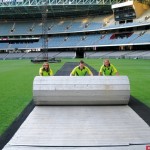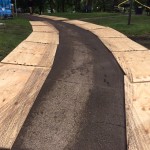Staging Guide
SAM 555 Mobile Stage, Courtesy of PGP
Staging for events and festivals can come in several different forms, but the vast majority will use either (click on the links below to jump to each section):• modular staging (such as Bil-Jax, which come in 4′ x 4′ sections)
• mobile staging (such as Stageline)
• scaffolding staging
• aluminum staging (such as Tomcat)
• steel staging
• mobile staging (such as Stageline)
• scaffolding staging
• aluminum staging (such as Tomcat)
• steel staging
Staging can be used for more than just performers, speakers, or other forms of entertainment; sometimes there will be a need to have a level floor in order to do kitchen prep, catering, or other work that can’t be done without a level, clear ground. There are a few options specifically designed for this sort of need.
Most stages will also require a roof – be it for shade, to hang lighting, sound, or video, and/or for signage. There are various roofing options but the main thing to consider is how safe the roof needs to be given the environment it will be in; most roofs will need to be inspected by local authorities and/or signed off by a third party engineering firm before your event or festival can use them. Some stage and roof systems will come with their engineering drawings already approved, but an inspection will still be mandatory to ensure they were constructed properly onsite.
Some stages may also need risers, be it a drum riser, a choir riser, or for other needs. Drum risers, for example, are usually 8′ wide x 8′ deep x 1′ or 2′ tall. For festival sets with multiple bands, it’s often necessary to have these risers on casters so they can roll easily. This helps ensure a quick and efficient set change.
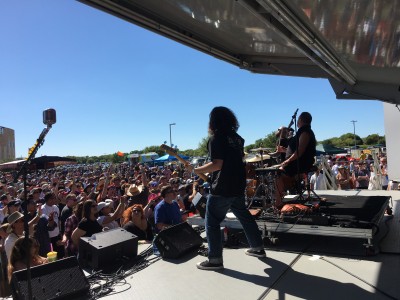
Cowboy Mouth utilizes an 8×8 rolling riser not in the usual upstage position but downstage close to the crowd.
Aside from the main performance area of the stage, it’s often necessary to have stage wings added on to support the needs of the artist(s) and the production companies handling the audio, lighting, and video. In most setups, the stage left wing will be for monitor world, and the stage right wing is for either a guitar world, dimmer beach, or video world. For festivals that have multiple bands playing, the wing space is essential to stage the bands’ gear so quick set changes can be achieved. Some events will allow VIPs to access part of the stage, and it’s always a good idea to barricade off that section and ensure they have a separate entry and exit.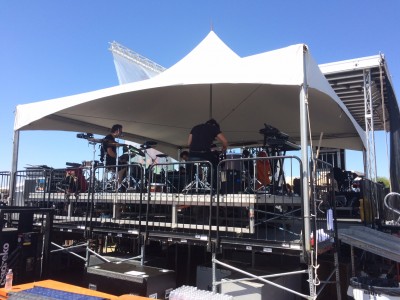
A stage left wing with monitor world and drum risers for various bands playing that day, ready to be moved to the stage. Note the truck ramp that allows road cases to be rolled up and down easily.
Another option to consider is building a loading dock behind or to the side of the stage, for easy access by vehicles to drop off and pick up gear. Larger stages will need to ensure their loading docks can handle one or multiple 53′ semi trailers if the artist and/or production companies are bringing their gear in semis.
Related to staging or flooring needs is ground protection. Some site builds will require having proper ground protection so that heavy machinery can properly drive on the grounds without damaging it.
Below are breakdowns for each kind:
- Modular stage decks / panels:
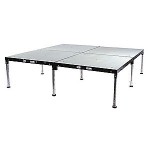 Wooden with a metal frame – these are the most common for virtually every stage build with the exception of mobile stages, which come with a stage floor built-in. However, modular decks may be used to extend the mobile stage dimensions and/or add wings. They often come in 4′ x 4′ sections.
Wooden with a metal frame – these are the most common for virtually every stage build with the exception of mobile stages, which come with a stage floor built-in. However, modular decks may be used to extend the mobile stage dimensions and/or add wings. They often come in 4′ x 4′ sections.
A popular manufacturer of this kind of staging is Bil-Jax. They can often be rented by local audio or party (tent, table, chair) vendors.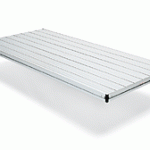 Aluminum frame deck – these are sturdier than the wooden decks and are more durable. They often come in 4′ wide by 8′ deep sections. These are often used in outdoor applications and/or events that call for a higher quality look & feel. You can choose from multiple surfaces – all aluminum, plywood, or special rigid plastics.
Aluminum frame deck – these are sturdier than the wooden decks and are more durable. They often come in 4′ wide by 8′ deep sections. These are often used in outdoor applications and/or events that call for a higher quality look & feel. You can choose from multiple surfaces – all aluminum, plywood, or special rigid plastics.
A popular manufacturer of this kind of staging is StageRight. These or similar makes can usually be rented by larger stage vendors.
- Mobile Stages – these kinds of stages are well known for their ability to be built quickly, easily, and provide excellent stability in the face of inclement weather. These are quickly becoming the staging of choice for events and festivals of all sizes.
View Mobile Stage Grid as a PDF
Name Dimensions Wind Resistance* Stated Rigging Capacity** Build Time / Crew Needs Notes Offered By 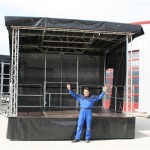
S Stage 14’6″ x 12’4″‘ 15 minutes, 1 person Roof height of 14′ 6″ 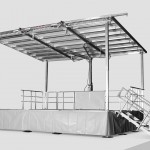
SL 50 20′ x 16′, up to 36′ x 20′ 80 mph w/o windwalls; 60 mph w/ windwalls 2,500 lb 30 minutes, 2 people 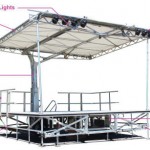
FrontRow 4300 Mobile Bandstand Stages 20′ x 16′, up to 20′ x 20′ 65 mph w/o windwalls; 45 mph w/ windwalls 4500 lbs 30 minutes, 1 person 13′ 1″ Canopy trim height; speaker hanger capacity of 800 lbs each Century Industries 
Apex 2016 20′ x 16′ 3,400 lb 30 to 60 minutes, 2 people 12’10” trim height (stage floor to lowest hanging point) Stagepro 
L- Stage 20′ x 22′ 30 minutes, 1 person Roof height of 15′
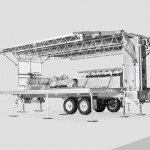
SL 100 24′ x 20′, up to 40′ x 32′ 80 mph w/o windwalls, 60 mph w/ windwalls 6,500 lb 30 minutes, 2 people Miller Pro Audio, PGP, Stageline / MSR 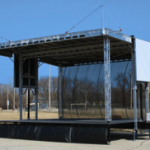
Apex 2420 24′ x 20′ 11,500 lbs 30 to 60 minutes, 2 people 13′ trim height (stage floor to lowest hanging point) 
SL 100 Mix 24′ x 20′ 80 mph w/o windwalls, 60 mph w/ windwalls 6,500 lb 90 minutes, 2 people Can hold up to 4 follow spots from 18′ 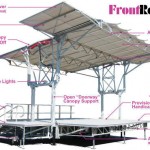
FrontRow 4500 Series 24′ x 23.8′ up to 40′ x 23.8′ 85 mph w/o windwalls, 60 mph with flybays and windwalls 4,000 lb 20-30 minutes, 2 people Canopy trim height – 15′ to 12′ 7″; speaker hangers can hold 1000 lb each
Century Industries 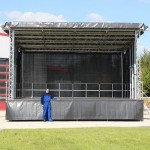
XL Stage 26′ x 20′ 30 minutes, 1 person Roof height of 20′ 8″
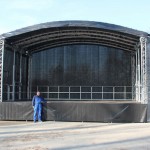
XLR Stage 30′ x 20′ 30 minutes, 1 person The only production round roof stage in the world
Roof height of 17′ 9″

SL 260 32′ x 24′ or 32′ x 32′, up to 56′ x 32′ 90 mph w/o windwalls, 60 mph w/ windwalls 18,500 lb 60 minutes, 2 people Has a covered wing option of 12′ x 20′ each; older version of this is the SL 250 Miller Pro Audio, Stageline / MSR 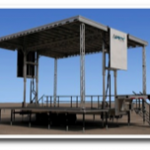
Apex 3224 32′ x 24′ 8,000 lbs 30 to 60 minutes, 2 people Stagepro 
XXL Stage 33′ x 20′ 40 minutes, 1 person Can fly 2k of audio per side on the wings
Roof height of 20′ 8″
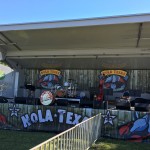
ShowMaster Sound Shell MSM3000 Series 32′ x 14′ or 36′ x 14′ none 1 person Can fly lights on optional light bars
Century Industries 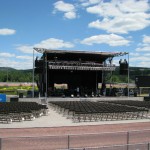
SL 320 40′ x 40′, up to 72′ x 40′ 90 mph w/o windwalls, 60 mph w/ windwalls 26,000 lb 2 hours 30 minutes, 4 people Trim height of 22′ – 25′ Miller Pro Audio, PGP, Stageline / MSR 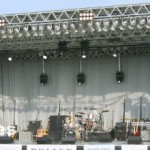
FrontRow 6000 Series 32′ x 23.3′ up to 40′ x 23.3′ 85 mph w/o windwalls, 60 mph w/ windwalls 19,000 lb 30-45 minutes, 2 people Canopy height 17.6 ft to 20.2 ft; speaker hangers can hold 2500 lb each Century Industries 
SAM 555 50′ x 38′, up to 90′ x 56′ 90 mph w/o windwalls, 60 mph w/ windwalls 58,000 lb 4 hours, 5 people 20′ x 32′ covered wing option; older version of this is the SAM 550; Trim height of 30′ PGP, Stageline / MSR 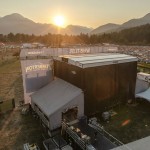
SAM 575 50′ x 38′, up to 90′ x 56′ 90 mph w/o windwalls, 60 mph w/ windwalls 94,000 lb 4 hours, 5 people 20′ x 32′ covered wing option; Trim height of 30′-33′ Stageline / MSR 
Apex 5040 50′ x 40′ 32,000 lb 32’3″ trim height (stage floor to lowest hanging point) Miller Pro Audio, Stagepro 
SAM 750 70′ x 48′ or 56′, plus two covered wings 28′ x 48′ each 90 mph w/o windwalls, 60 mph w/ windwalls 152,000 lb 16 hours, 12 people 52′ trim height Stageline / MSR * While structural failure may not occur until the stated wind speeds, virtually every High Wind Action Plan will require the stages secured and site evacuated at 40mph
** Please consult the manufacturer or an authorized sales representative for proper rigging capacities – these are just an overall estimate and should not be relied upon without confirmation from signed and stamped engineering drawings
 Scaffolding Stages – these kinds of stages are known for their stability and adaptability. They are build using steel scaffolding with a wooden, metal, or tarp roof, and their sizes can range from 20′ wide to 80’+ wide.
Scaffolding Stages – these kinds of stages are known for their stability and adaptability. They are build using steel scaffolding with a wooden, metal, or tarp roof, and their sizes can range from 20′ wide to 80’+ wide.
For more information on these kinds of stages, you can visit ASAP or Upstage Center.
 Aluminum Stages – these kinds of stages offer a nice clean look & feel using aluminum truss with canvas or tarp roofs. They are available in multiple sizes and can normally withstand a good amount of wind load.
Aluminum Stages – these kinds of stages offer a nice clean look & feel using aluminum truss with canvas or tarp roofs. They are available in multiple sizes and can normally withstand a good amount of wind load.
Some vendors that offer Tomcat staging include Miller Pro Audio and Crosswind Systems.
Below are some common sizes of Tomcat roofs.Size More information 
45′ x 45′ Spec Page 
65′ x 45′ Spec Page
- Steel Stages – these heavy-duty stages are best for large scale festivals where the artists require a minimum stage width of 60′ and enough rigging capacity to handle most A-List acts’ requirements.
Below are some options of steel stages:Name Dimensions Notes Offered By: 
PGP 6040 60′ wide x 40′ deep Perspective View PGP 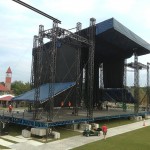
PGP 6068 60′ wide x 68′ deep Perspective View PGP 
PGP 8060 80′ wide x 60′ deep Perspective View PGP 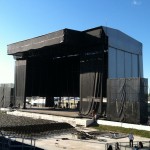
Mountain Truss 80′ wide x 60′ deep Capable of supporting 400,000 lbs Mountain Productions - Ground Protection – some events require that their grounds stay protected from heavy machinery or other vehicles; ground protection can also mean laying down specialized flooring for pedestrian traffic as well.
A global vendor for ground protection options, EPS, offers several different solutions.
Below are some examples of ground protection: - How to choose the right kind of stage for your event – you will want to consider the following factors:
- Artist selection and their requirements – what is the minimum size stage they need? How much rigging capacity will they need to hang their lights, video, and sound?
- General look and feel of the event – the steel stages can provide that big and bold look, but often a smaller mobile stage, when done up with banners and wings, can have virtually the same level of impact.
- Weather / environmental concerns – most mobile stages are able to withstand a greater amount of wind than aluminum stages, something to keep in mind especially if you are going to be outdoors.
- Labor costs / time to build and strike – mobile stages take less time to build, but are not as modular / scalable as the other stage options.



